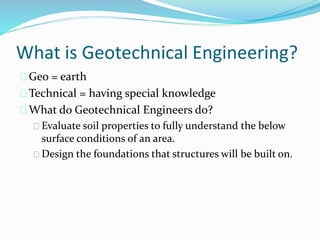The Greatest Guide To Geotheta
The Greatest Guide To Geotheta
Blog Article
Getting The Geotheta To Work
Table of ContentsAll about Geotheta4 Simple Techniques For GeothetaSome Ideas on Geotheta You Need To KnowThe Only Guide for Geotheta
They team up with civil engineers, structural engineers, architects, and other professionals to incorporate geotechnical considerations right into the total job style and building process. This requires effective team effort, coordination, and interaction to make sure that the geotechnical facets line up with the project purposes and fulfill regulative requirements.Mining & Products Engineering: Principles of boring, penetration prices, and elements influencing the option of drilling technique. Qualities of nitroglycerins, shooting systems and blast patterns. Blasting strategies in surface and underground workings. Special blowing up techniques at excavation boundaries. Vibration and noise control. Mechanical and constant techniques to fragmentation, consisting of longwall shearing and fullface boring.
Modelling of fragment and bit dimension distributions; comminution as a transfer feature. Comminution technology: squashing, grinding, dimension classification. Integrated analysis of fragmentation and comminution operations. Used by: Mining & Products Design.
The smart Trick of Geotheta That Nobody is Discussing
Bachelor's level programs in civil, geotechnical, geological, and ecological engineering usually last four years and include basic education and learning training courses in English, social scientific research, and the humanities, as well as programs in advanced mathematics, structural geology, and fluid mineralogy. (https://www.twitch.tv/geotheta/about)
Geotechnical design involves the analysis of the dirt and rock conditions at a certain site, and their implications for the advancement of that site. As most frameworks count on the ground for support, it is without surprise that a detailed understanding of the ground conditions, and the suitability of foundation systems, are important to the long-lasting security and efficiency of the building or framework.
Specialising in the investigation of geological formations and ground behavior, geotechnical designers execute clinical examinations and screening to recognize the effect these geological developments might carry the design and building of structure, civil and framework tasks. This expertise is crucial for the design and construction of buildings, roadways, tunnels, dams, bridges, and supply of water and sewer system.
The geotechnical group at Douglas Allies regularly speak with designers, design designers, designers, and building contractors to make referrals on style and advancement proposals to make sure that the built frameworks are accordingly designed for the ground problems. For instance, the design of footing systems requires to take into consideration the weight of the structure, the ability of the ground to support that weight with each other with activity resistances and reliable building and construction.
Not known Details About Geotheta
This task is considerably streamlined by the use of our Douglas Map geospatial system that makes this details easily accessible in a simple to make use of web internet browser interface. A geotechnical designer will guide the boring of boreholes and examination pits to accumulate dirt and other samples, and likewise assess surface area features and ground direct exposures to create a geotechnical design of the subsurface problems.
Depending upon the job type and ground conditions came across, laboratory screening might to name a few points examine strength, compressibility, sensitivity and/or leaks in the structure of dirt and rock samples. Hereafter information is collected and collated, the outcomes are utilized for a geotechnical version of the site, which is normally presented as areas throughout the site.

A geotechnical examination naturally can only assess the ground problems at the places drilled or excavated. Natural variants in dirt and rock conditions can occur across a site and between test places. It is consequently good practice that the geotechnical designer be maintained throughout building and construction of the job to offer on-site verification that the ground problems come across follow the assumptions and suggestions offered in the geotechnical examination record.
Geotheta Things To Know Before You Get This
Geotechnical designers use their thorough expertise of dirt and rock to evaluate threat and address issues on diverse framework projectsGeotechnical design is a specialist branch of civil engineering which takes a look at the behaviour of planet materials and the application of soil and rock technicians. Consulting Engineer. As a geotechnical engineer, you will analyze the physical, mechanical and chemical residential properties of soil and rock in order to create foundations, preserving structures and earthworks
Geotechnical design is carefully connected to and overlaps with, both engineering geology and ground design - https://geotheta.jimdosite.com/. It's feasible to be experts in geotechnics or help a geotechnical business but be referred to as a design rock hound or a ground designer. As a geotechnical engineer, you'll require to: develop and preserve partnerships with clients and other specialists included in the website, throughout each projectmaintain security requirements on website be mindful of expense ramifications when you make recommendationsstudy geological maps and airborne pictures from a series of sources and from different time periodsexamine building plans to see exactly how possible they are based upon your understanding of the siteinvestigate dangers or geological hazards for the sitesearch for ecologically delicate features, such as land fill begin to create factual and expository ground modelsplan field investigationsdrill and evaluate samples of bedrock, dirt, groundwater and additional products oversee other specialists on sitesolve technical problems as they arise, such as unanticipated frameworks at drill sitesmonitor conditions throughout and after construction to make certain frameworks are stable in the brief and lengthy termadding data gathered on site to your first researchcreating geotechnical calculations, illustrations, and 2 or three-dimensional computer system versions translating the datamaking recommendations concerning the proposed use of the website

Report this page